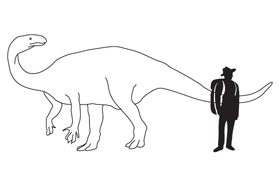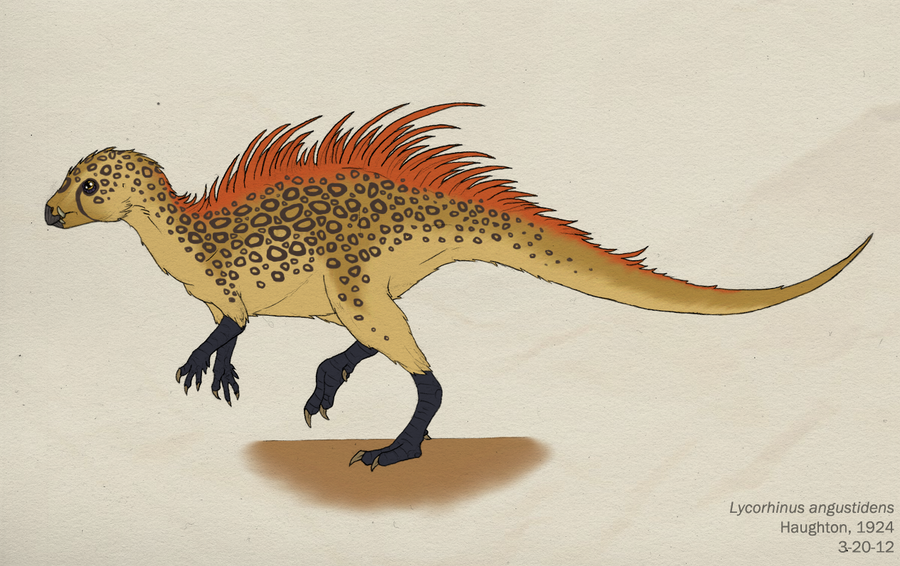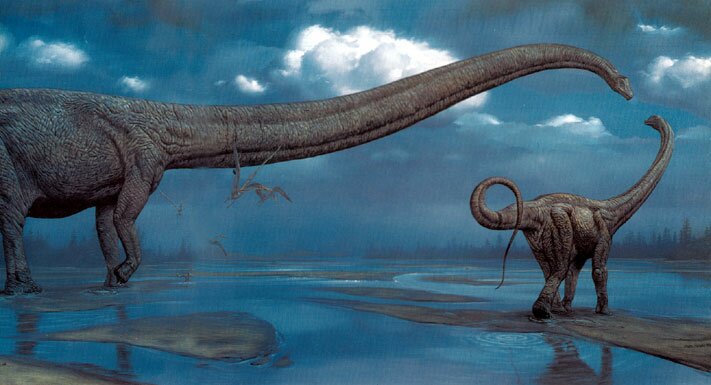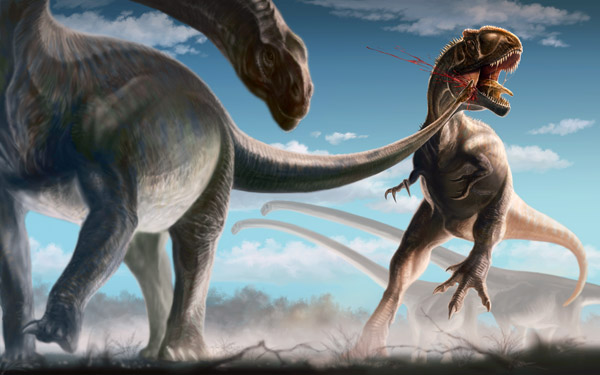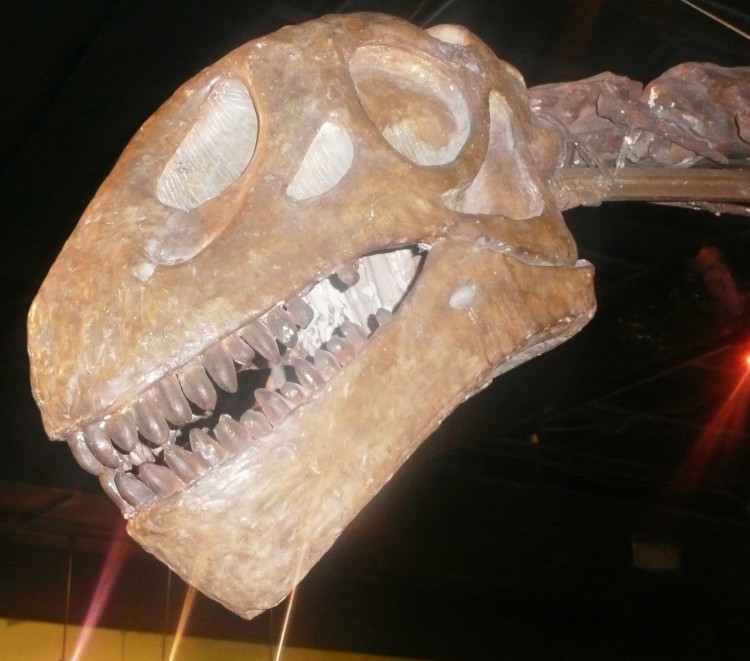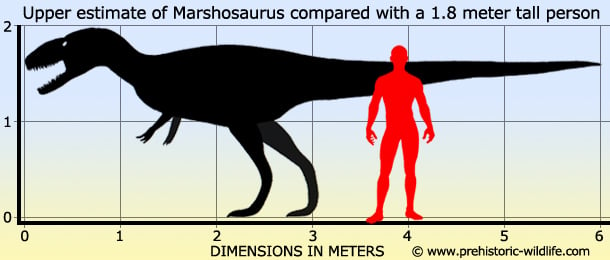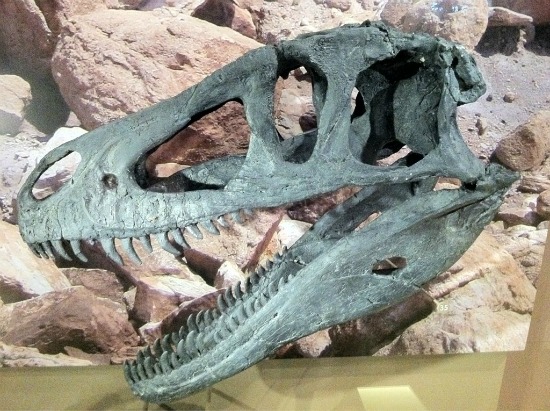[Recent Entries][Archive][Friends][User Info]
November 5th, 2012
| November 5th, 2012 | |
|---|---|
| 06:06 pm [industrialterro] [Link] |
Lufengosaurus Люфенгозавры (Lufengosaurus) — род семейства массоспондильных отряда ящеротазовых динозавров. Люфенгозавры обитали на территории нынешнего Китая в эпоху нижней юры. Типовой экземпляр люфенгозавра был обнаружен в округе Луфэн провинции Юньнань. Луфенозавр был первым видом динозавра, полный скелет которого был найден на территории Китая. В 1941 году китайским учёным Ян Чжунцзянем был описан вид L. huenei. В 1947 он описывает второй вид этого рода, L. magnus. Последний был на 1/3 крупнее, чем L. huenei. В 1981 году некоторыми исследователями было предложено рассматривать люфенгозавра как одну из разновидностей южноафриканского рода Massospondylus. Проведённое в 2005 году новое подробное исследование черепа люфенгозавра указало, что он является представителем отдельного рода подгруппы прозавроподов. Как и все прозавроподы, люфенгозавр обладает длинными задними и передними конечностями. Длина животного достигала 6 метров. Люфенгозавры частично передвигались на задних лапах, особенно когда обрывали листву с деревьев. Люфенгозавр были исключительно растительноядны. В то же время, они обладали острыми зубами и когтями (особенно длинными и острыми на больших пальцах передних конечностей). Высказанное в связи с этим предположение, что люфенгозавры были всеядными животными, своего подтверждения не нашло. Острые когти использовались ими исключительно в целях обороны и при собирании растительной массы для питания. В 1958 году почтовое ведомство КНР выпустило специальную почтовую марку, посвящённую выставленному на всеобщее обозрение, полностью восстановленному скелету люфенгозавра. Lufengosaurus is often described as a rather small prosauropod, about 6 metres (20 ft) long. However, when the "L. magnus" specimens are included, its size is more considerable: Gregory S. Paul estimated a length of 9 metres (30 ft) and a weight of 1.7 metric tons (1.9 short tons) in 2010. For a prosauropod, its neck is rather long and the forelimbs are relatively short. From these it was inferred that the species was bipedal, even before it became common to assume this for all basal sauropodomorphs. Yang published a full osteology of Lufengosaurus in 1941, but was severely hampered in his diagnosis by the war conditions, preventing a full access to literature and making an adequate comparison with related forms impossible. Of the skull a modern description exists. The skull of the holotype is 25 centimetres (9.8 in) long. Yang assigned Lufengosaurus to the Plateosauridae and this is still a common classification in China. Some cladistic analyses have found Lufengosaurus as a member of the Massospondylidae. Like all prosauropods, Lufengosaurus had much longer hindlimbs than forelimbs and was probably bipedal some of the time, especially when browsing for food. It was herbivorous, although it had sharp claws (with an especially large thumb claw) and teeth. These features have been used to support claims, the most recent by Cooper in 1981, that Lufengosaurus may have been at least partially omnivorous, but the sharp teeth witnessed in Lufengosaurus and other prosauropods are similar to those seen in iguanaian lizards — which are herbivorous. Alternatively, the claws may have been used for defense or raking foliage from trees.
Размеры тела в сравнении с человеком:
Ископаемые останки и реплики (1, 2, 3, 4, 5, 6, 7):
( Read More ) Tags: Вымершие рептилии, Юра, авеметатарзалии, архозавроморфы, архозавры, диапсиды, динозавроморфы, динозавры, завроподоморфы, массоспондилиды, прозавроподы, ящеротазовые |
| Time | Event |
| 06:46 pm [industrialterro] [Link] |
Lycorhinus Ликоринус (λυκος — волк и ρινχος — нос) — растительноядный динозавр юрского периода. Питался ликоринус растительной пищей, хотя на верхней и нижней челюстях у него росли зубы, наподобие крупных клыков, характерных для плотоядных животных. Возможно, клыки служили этому маленькому динозавру средством защиты от хищников, для которых он мог стать легкой добычей. Лишенным зубов клювом ликоринус отщипывал побеги и жевал их тупоконечными зубами. Ликоринус известен с 1924 года. Именно тогда была найдена его левая челюсть, и из-за наличия клыков палеонтологи приняли его за примитивную рептилию с чертами млекопитающего. Но после находки в 1962 году гетеродонтозавра было выявлено их близкое родство, и в итоге ликоринус был отнесен к динозаврам. Lycorhinus is a genus of heterodontosaurid ornithischian dinosaur hailing from the Early Jurassic (Hettangian to Sinemurian ages) strata of the Elliot Formation located in the Cape Province, South Africa. The fossil material consists of dentaries and maxillae, hence the characters mentioned by the name Lycorhinus angustidens that Sidney H. Haughton attributed to the remains in 1924, where the generic name means "wolf snout", as it was at first misidentified as a cynodont, and the specific descriptor means "constricted tooth". The holotype, SAM 3606, consists of a mandible found by Dr M. Ricono. Three other species of Lycorhinus have been named. Lycorhinus parvidens was created by Robert Broom and Lycorhinus tucki by Richard Anthony Thulborn in 1970 renaming Heterodontosaurus tucki, but these have failed to find recognition. Lycorhinus consors, named by Thulborn in 1974, was renamed Abrictosaurus by James Hopson in 1975. Lycorhinus, including the remains described by Gow in 1975 as Lanasaurus, is a small (1.2 metres (47 in) in length) herbivorous dinosaur despite the long canines it sported in its jaws; in view of this typical characteristic L. angustidens is very clearly allied to Heterodontosaurus. Only in 1962 Alfred Walter Crompton recognised it was an ornithischian dinosaur. Thulborn in 1971 created a separate Lycorhinidae but this group was in 1972 equated with Heterodontosauridae by Peter Galton. The type and only species of Lanasaurus is L. scalpridens, described by Christopher Gow in 1975 from the same horizon as Lycorhinus. The generic name is derived from Latin lana, "wool" and Greek saurus, "lizard", and honours Professor Alfred Walter Crompton, nicknamed "Fuzz" because of his woolly hair. The specific name is derived from Latin scalprum, "chisel", and dens, "tooth". It is based on a partial upper jaw bone, the maxilla, holotype BP/1/4244, found in the Upper Elliot Formation of Free State. The teeth show a typical replacement pattern in which during each replacement cycle every third tooth is renewed. Gow himself in 1990 concluded that the holotype of Lanasaurus was actually a specimen of Lycorhinus angustidens. This has been commonly accepted since
Tags: Вымершие рептилии, Юра, авеметатарзалии, архозавроморфы, архозавры, гетеродонтозавры, диапсиды, динозавроморфы, динозавры, птицетазовые |
| Time | Event |
| 07:03 pm [industrialterro] [Link] |
Magnosaurus Magnosaurus (meaning 'large lizard') was a genus of basal tetanuran theropod dinosaur from the Middle Jurassic of England. It is based on fragmentary remains and has often been confused with or included in Megalosaurus. In 1923, Friedrich von Huene named Megalosaurus nethercombensis from a partial skeleton (OUM J12143) from the Aalenian-Bajocian-age Middle Jurassic Inferior Oolite, found in the nineteenth century by W. Parker near Nethercomb, north of Sherborne, in Dorset, England. The material included partial dentaries, dorsal and caudal vertebrae, a partial ilium, a partial right pubis, internal casts of the femora, and tibiae, from a possibly juvenile individual. Huene interpreted it as a more primitive species of Megalosaurus. In 1926, he named the tooth species Megalosaurus lydekkeri for a specimen, BMNH 41352, from the Lower Lias (Lower Jurassic) of England that Richard Lydekker had first described in 1888. Finally, in 1932, he created the genus Magnosaurus for M. nethercombensis, referred M. lydekkeri to it, and created a third species, M. woodi, for the genus. M. woodi was based on a tibia (BMNH R.3542) from the Lower Lias, which he simultaneously and accidentally also named Sarcosaurus andrewsi; the latter name was in 1956 by von Huene given priority. Even more confusing, in the same 1932 publication von Huene renamed Sarcosaurus woodi into Magnosaurus woodi. Until the 1990s, the genus had been ignored as a species of Megalosaurus. However, with growing concern over what exactly is constituted by Megalosaurus, Magnosaurus has been generally separated as its own genus. Also, there are morphological differences: for example, possible Megalosaurus tibiae are compressed at the far end, unlike those of Magnosaurus. Rauhut (2003) considered it and Eustreptospondylus to be the same genus, because the two share a similarly expanded front tip of the dentary and enlarged third dentary tooth. He therefore renamed Eustreptospondylus oxoniensis a Magnosaurus oxoniensis but this has not been generally followed. Reviews have found it to most likely be a basal tetanuran, probably a megalosaurid. A detailed redescription by Roger Benson in 2010 concluded Magnosaurus was valid taxon, a megalosauroid megalosaurid, and at about 175 million years old the oldest certain known member of the Tetanurae. Because the remains are sparse and fragmentary, details about the life and behaviour of Magnosaurus are unknown. It would have been a bipedal carnivore of moderate size for a dinosaur. The most similar animals probably would be animals like Eustreptospondylus, Dubreuillosaurus, and Afrovenator. Paul (1988) roughly estimated the mass of the type individual as around 175 kg (386 lb), which would correspond to a length of roughly four metres (13.1 ft), judging by his estimates for the sizes of other theropods. Benson however, in 2010 gave a higher estimation of about half a tonne; the animal would have stood at over a metre at the hip.
Размеры тела в сравнении с человеком:
Tags: Вымершие рептилии, Юра, авеметатарзалии, архозавроморфы, архозавры, диапсиды, динозавроморфы, динозавры, мегалозавриды, тероподы, ящеротазовые |
| Time | Event |
| 07:19 pm [industrialterro] [Link] |
Mamenchisaurus Маменчизавр (Mamenchisaurus) — род позднеюрских травоядных динозавров, существовавший 150—145 млн лет назад (последняя треть юрского периода). Обнаружен на территории современного Китая. Отнесён к подотряду зауроподы. Является динозавром с самой длинной шеей, которая, по некоторым данным, достигала 15 метров в длину. Название Mamenchisaurus означает "ящерица из Мамэньси", от пиньинь «Mǎménxī» — Мамэньси и греческого «saurus» - ящерица. Первоначально решили назвать динозавра по месту находки - близ местности Маминси (пиньинь Mǎmíngxī) в провинции Сычуань. Однако в результате ошибки, допущенной Янгом, вместо Маминси было указано имя Мамэньси. Маменчизавр был открыт в 1952 при строительстве дороги в Сычуане, Китай. Части окаменелого скелета изучал и дал название виду в 1954 известный китайский палеонтолог профессор Янг. Первый экземпляр был 22 метра в длину. И половина из этой общей длины приходилась на шею, что делает маменчизавра самым длинношеим животным, когда-либо существовавшим на Земле. Шея маменчизавра состояла из 19 позвонков (следует заметить, что ни у какого другого известного динозавра стольких шейных позвонков не имелось). Есть предположения, что взрослые особи могли достигать 25 метров в длину. В 1987 году были обнаружены различные разновидности маменчизавра (M. hochuanensis) с шеей длиной 15 метров. Тот факт, что первые останки маменчизавра были найдены на месте строительства, стал причиной того, что профессор Янг дал виду название Mamenchisaurus constructus (от англ. construct — строить). Другие виды маменчизавров: M. anyuensis He, Yang, Cai, Li & Liu, 1996 M. constructus Young, 1954 M. fuxiensis Hou, Zhao & Chu, 1976: Неполный скелет, включающий части черепа. Вначале был назван зигонгозавром. Возможно, относится к другому роду. M. hochuanensis Young & Zhao, 1972: Четыре неполных скелета. M. sinocanadorum D. Russell & Zheng, 1994: Неполный череп, отдельные кости. Возможно был самым большим, достигая 26 метров в длину. M. youngi Pi, Ouyang & Ye, 1996: Mamenchisaurus youngi был найден возле города Зигонг провинции Ксинмин в Сычуане в 1989 г. Скелет данного вида достигает 16 метров в длину с 6,5-метровой шеей, что делает особей данного вида сравнительно небольшими по сравнению с особями других видов. Вид был назван в честь профессора Янга. Mamenchisaurus ( Mamenchisaurus was first discovered in 1952 on the construction site of the Yitang Highway in Sichuan, China. The partial skeleton fossil was then studied, and named Mamenchisaurus constructus in 1954, by the renowned Chinese paleontologist Professor C. C. Young. The type specimen had an incomplete neck with 14 vertebra preserved and none of these were complete . M. constructus was estimated at 13 m (43 ft) long. In 1972, a second species of Mamenchisaurus was discovered (M. hochuanensis) with a neck that reached up to 9.3 m (31 ft) in length. This species had a complete neck preserved which contained 19 vertebrae. In 1994, Sauroposeidon was discovered in the United States, with a neck estimated to be between 10.5 and 11.5 meters (34.5–37.5 feet) long, though its neck did not exceed that of the previously known Supersaurus, with a neck reaching 13–14 meters (42.5–46 feet). In 1993, M. sinocanadorum was described; this species possessed the longest cervical rib of any described sauropod dinosaur, measuring 4.1 m (13.5 ft). This is longer than the longest Sauroposeidon cervical rib, which measures 3.42 m (11.2 ft). In 2001, another M. hochuanensis specimen was described. It had skull, pectoral girdle and forelimb material preserved, all of which were missing from the holotype. It was also found with four fused tail vertebra, which have expanded neural arches and taller neural spines, that belong at the tip of the tail. It’s thought that these could be a weapon, such as a tail club, or a sensory organ. Other Chinese sauropods, Shunosaurus and Omeisaurus, are also known to have had ’tail clubs’ but they differ in shape to that of M. hochuanensis. Половину от общей длины тела маменчизавра составляла тонкая шея, которая была длиннее трех поставленных бампер к бамперу автомобилей. Репродукции (1, 2, 3, 4, 5, 6, 7, 8, 9):
( Read More ) Размеры тела в сравнении с человеком:
Ископаемые останки и реплики (1, 2, 3, 4, 5, 6, 7, 8):
( Read More ) Tags: Вымершие рептилии, Юра, авеметатарзалии, архозавроморфы, архозавры, диапсиды, динозавроморфы, динозавры, завроподоморфы, завроподы, маменчизавриды, ящеротазовые |
| Time | Event |
| 08:06 pm [industrialterro] [Link] |
Marshosaurus Marshosaurus was a genus of medium sized theropod, with a size up to 5 or 6 meters (16 to 20 feet) in length and a skull about 60 cm (2 feet) long. It is known from parts of at least three (possibly four) individuals from the Morrison Formation of Utah and Colorado. The holotype is a left ilium, or upper pelvis bone found at the Cleveland-Lloyd Quarry in central Utah. It was named by James Madsen (1976) for Othniel Charles Marsh, who described many dinosaur fossils during the Bone Wars. The species name was chosen "in honor of the bicentennial of the United States of America". Characters on the skeleton show it was an avetheropod, a member of Avetheropoda, a group of more bird-like theropods including Tyrannosaurus, Velociraptor and Allosaurus. Benson (et al., 2009) found it to be a megalosauroid, using a lot of new characters of new Megalosaurus specimens. It lived during the Kimmeridgian (Late Jurassic), approximately 155 - 150 mya. One right ilium of a Marshosaurus bicentesimus is deformed by "an undescribed pathology" which probably originated as a consequence of injury. Another specimen has a pathological rib. In a 2001 study conducted by Bruce Rothschild and other paleontologists, 5 foot bones referred to Marshosaurus were examined for signs of stress fracture, but none were found.
Размеры тела в сравнении с человеком:
Tags: Вымершие рептилии, Юра, авеметатарзалии, архозавроморфы, архозавры, диапсиды, динозавроморфы, динозавры, мегалозавриды, тероподы, ящеротазовые |
| Previous Day | 2012/11/05 [Archive] |
Next Day |





